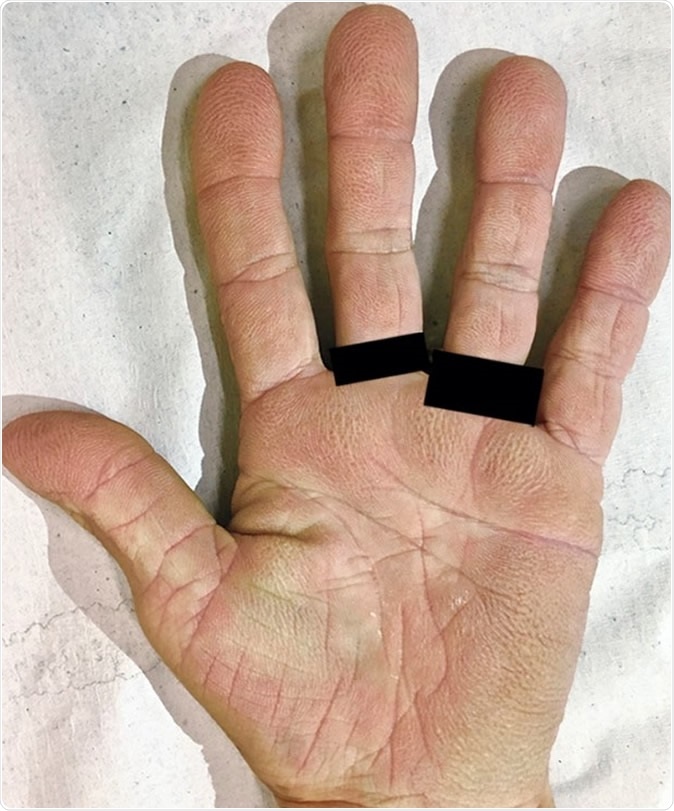A 73-year-old woman presented with pruritic, itchy, and painful lesions on her hand, showing an appearance consisted of tripe palms. It was later revealed by doctors that her velvety palms turned out to be a rare sign of lung cancer.
The patient, who was from Brazil, consulted a dermatology clinic presenting with painful and itchy lesions on her hands and was diagnosed with tripe palms. Her hands resembled tripe, which is a rippling stomach lining in animals, like pigs, sheep, and cows.
“Physical examination revealed sharp demarcation of the folds in the lines of her hands in addition to a velvety appearance of palmar surfaces and ridging of the skin,” the doctors wrote in the case report.
The case, which was published in The New England Journal of Medicine, showed the patient is a heavy smoker with a smoking history of 30-pack years. She had chronic and persistent cough over the last year and had lost about 11 pounds spanning four months. All these signs and symptoms indicated that she might have cancer.

Velvety Palms, Denis Miyashiro, M.D., and Jose A. Sanches, M.D., Ph.D. Image Credit: The New England Journal of Medicine Publisher: Massachusetts Medical Society
The woman underwent a series of tests, including computed tomography scans of her chest, abdomen, and pelvis, and revealed that she has adenocarcinoma, a type of lung cancer. In her CT scan, there is an irregular nodule in the left upper lobe of the lungs. She also had enlarged mediastinal lymph nodes.
Adenocarcinoma is a type of cancer that forms in the glandular cells in various body locations, such as the colon, lungs, prostate, breast, and pancreas.
“Tripe palm lesions may resolve with treatment of underlying cancer; however, the lesions in this patient did not regress with chemotherapy or with the application of 10 percent urea-containing ointment,” the doctors said.
The doctors reported that after six months after the patient consulted the dermatology clinic, her cancer progressed, and when the case report is being written, the woman began her second round of chemotherapy. However, it is unknown if the second phase of chemotherapy was successful in fighting cancer.
The doctors reiterate than even skin changes can hint the presence of underlying cancer or malignancy. It’s important to note that his rare skin disorder, tripe palms, is serious, and the patient should seek medical help as soon as possible.
“Therefore, all patients with tripe palms should be evaluated with a full diagnostic workup for an associated malignancy, particularly lung or gastric carcinoma,” the doctors added.
Tripe palms and cancer link
Tripe palms, also known as acanthosis palmaris or acquired pachydermatoglyphia, are characterized by thickened velvety palms that look like tripe. About 90 percent of tripe palms cases are linked to internal malignancy.
First described in 1977 by a London dermatologist, Dr. Jacqueline Clarke, tripe palms present a thick and moss-like appearance. The condition is very rare; hence, there is only a limited body of research and evidence about it.
Having velvety surfaces on the palms aren’t always itchy or painful. Though the exact cause of the changes in the skin is still unknown, the ridges on the hands are tied to an internal malignancy or cancer.
The exact cause of developing tripe palms is still unclear, but experts say that it stems from underlying cancer, which releases substances that stimulate the palmar skin cells to proliferate.
The most common types of cancer associated with tripe palms are stomach (35 percent) or lung (11 percent) cancer.
What is adenocarcinoma of the lungs?
Lung adenocarcinoma is a type of lung cancer, which is considered a non-small cell lung cancer. This type of lung cancer accounts for more than 30 percent of all lung cancers, and approximately half of all non-small cell lung tumors.
The tumor usually develops in glands that secrete mucus and, in the alveoli, the tiny airway sacs that pump air in and out of the lungs, and where gas exchange happens.
The most common signs and symptoms include persistent cough, chest pain, shortness of breath, raspy voice, unexplained weight loss, and coughing up blood.
Journal reference:
Miyashiro, D., and Sanches, J. (2019). Velvety Palms. The New England Journal of Medicine. https://www.nejm.org/doi/full/10.1056/NEJMicm1902529?query=TOC